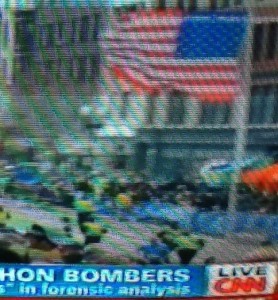Liberty versus security in Boston
We’re going to need to come to grips with the appropriate role of surveillance in our society. That’s one lesson from the bombings at the Boston Marathon.
We’ve spent billions in Afghanistan on eavesdropping equipment, wide area surveillance cameras, and cellphone tracking technologies to find improvised explosive devices and the people who plant them. It’s a problem similar to the one the FBI and Boston police are facing.
Makeshift bombs still go off in Afghanistan, but the toll would be far higher without surveillance data and the intelligence analysts who make sense of it all.
It’s time for us to decide which of these skills, devices and software can be applied at home and under what circumstances, while still keeping America America.
The country has been in a tug-of-war between liberty and security ever since the Sept. 11 attacks.
“The balance swung yesterday for sure,” said Brad Barker, president of the HALO Corporation, a California-based security firm.
The question is how far the pendulum should be allowed to swing. Even the most ardent intelligence and security advocates fear to think where too much zeal could lead us:
“There will be times when you make the choice: We’re going to be a little less safe because we’re not going to go do that,” former CIA and NSA director Michael Hayden said in a February speech.
In the wake of the Boston attacks, the country needs to get to work on a national strategy for domestic surveillance of large events. The strategy needs to be genuinely transparent, it should have well-defined limits, and it should spell out coordination with state and local jurisdictions.
In the years since Hurricane Katrina, the federal government and local jurisdictions have learned to coordinate well on disaster response. They can do the same on intelligence and surveillance.
Compromises are going to be required, that's for certain. Flying wide area surveillance cameras over major cities 365 days a year would be impossibly expensive, even if it were in our national character. But doing that for major events like the Boston Marathon is starting to sound more like prudence than a violation of our civil liberties.
Where would the money come from? We're spending billions on warplanes that will never go to war, missiles that will never be fired, and radios that do a smidgeon of what the phone in your pocket can do. We could find the money if we wanted to. The calculation is a cold one: How much should we spend securing crowds from what are likely to remain rare attacks?
As for civil liberties, somehow we’ve put ourselves in a situation where city governments routinely give out traffic tickets based on the views from cameras, and yet the idea of the government flying cameras overhead is somehow taboo. And so, investigators in Boston are reportedly left to stitch together video clips from cameras on buildings or those carried by bystanders.
At some point, the liberty to attend a sporting event outweighs the discomfort of knowing you’re being watched.
We need a domestic security strategy and we need it quickly, partly because the threat is here and now, and partly because decisions must be made about which intelligence, surveillance and reconnaissance technologies should become our spending priorities in the post-Afghanistan era.
Before the Boston bombings, intelligence and security companies were trying to shoehorn their way into homeland security applications, but mostly for border monitoring or to find drug smugglers in the Caribbean. Few have wanted to touch the hot-button issue of surveillance over major American cities.
Not all the techniques used in Afghanistan can or should be adopted domestically. In the war zone, eavesdropping on cellphone calls and pinpointing the locations of the people using them are regular parts of business. Those can't be done routinely here, and the level of risk doesn't justify it. But wide area surveillance cameras would be less intrusive and more transparent. You'd see the tethered aerostats or drones carrying them.
These cameras generate images of city-sized areas a few times a second. When a bomb goes off in Afghanistan, experts run the motion imagery backwards and try to figure out who planted the bomb.
Forensics is one thing. Better would be to detect suspicious activity in time to stop it, either through intelligence collections or surveillance closer to an event. With wide area surveillance, that would require software to automatically alert security personnel or analysts. The areas are just too vast for analysts to monitor in real time.
Is homeland security one reason to invest in automation software that might solve that problem?
A national plan for domestic surveillance would tell us.



